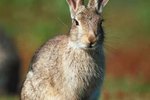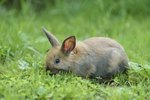
Cottontail rabbits live in much of the Americas and are essential to the survival of many of the other animals around them. They can be found as far north as Canada and as far south as South America. This rabbit used to live mostly in forests, deserts and other uninhabited areas, but it has adapted to humans and can often be found living in suburban backyards and open fields.
Bunny Vegetarians
Cottontails are vegetarians that eat grasses such as rye and clover along with other plants, including wild strawberries in season. They’ll also sneak into gardens at night and eat just about any kind of vegetable they can reach. When they can’t find their summer favorites, cottontails eat the bark and twigs from trees such as sumac, oak and dogwood. They typically eat first thing in the morning or just after the sun goes down.
Feces for Extra Nutrition
The plants the rabbit lives on are mostly difficult to digest, so it’s not easy for a rabbit to get enough nutrients the first time around. To solve this problem cottontails eat their food once and it passes through their systems where it is partially broken down. Next it emerges from the anus as soft fecal pellets. The rabbits eat these as they emerge and digest them again, this time extracting the full value of the nutrients from the food.
Breeding and Nesting Habits
Rabbits aren’t picky about choosing a mate. A female cottontail that’s ready to breed generally will accept any available male. After a short gestation period, usually around a month, the female scratches out a depression in the ground, lines it with grasses, leaves and her own fur, and gives birth to about five young. Cottontails aren’t very good moms and the infant mortality rate is high, but she’ll breed again soon after giving birth and can have several litters in a single season. She weans the babies and they are on their own by the time they’re 2 to 4 weeks old.
Cottontails and the Food Chain
Cottontail rabbits of all ages are an essential part of the food chain in every area in which they live. These rabbits provide necessary protein for foxes, bobcats, owls, snakes, hawks and many other predators. According to the Virginia Department of Game and Inland Fisheries, even red squirrels hunt and devour young cottontails as part of their regular diet.
Life Span
A cottontail living in the wild typically has a life span of two years or less, due in large part to its importance as a prey animal. In many places approximately 80 percent of all adult cottontails are killed by predators or disease every year, and about half the babies never live longer than a month. The population as a whole can survive these huge losses because the rabbits are so prolific and enough rabbits always manage to survive to keep their numbers strong.
References
Photo Credits
-
NA/AbleStock.com/Getty Images



